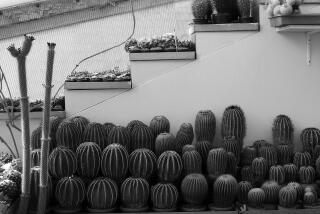Succulents Can Drown in Attention
- Share via
Succulent is a broad name for any plant with fleshy stems or leaves. Many have interesting, sometimes grotesque, shapes. Some have surprisingly bright flowers.
Succulents other than cactus are represented by only a few plant families, one of which is the orpine family. One orpine is the jade plant, a shrub native to the dry, sunny regions of Africa. As a houseplant, the jade plant develops into a beautiful little tree. Kalanchoe is another orpine, a plant notable for salmon-red flowers and a unique way of multiplying. Small plantlets growing along the edges of the leaves periodically drop off to make new plants. Hence another name for the plant: mother-of-thousands.
Sedums, also in the orpine family, include the familiar hens-and-chicks. Another sedum is burro’s tail, its stems hidden beneath braids of thick, fleshy leaves. The weight of the leaves pulls down the stem so that the plant cascades from the edges of hanging planters or, in its native Mexican habitat, from rocky crevices or sunny canyon walls.
*
The spurge family is another plant family with succulent members. With its spines, thick stem and lack of leaves, milk-striped euphorbia--named for the milky line down its stem--could be mistaken for a cactus. Crown-of-thorns, aside from its beautiful pink flowers, is another spurge armed with spines as fierce as those of any cactus.
The lily family is a third plant family with many succulent members. You have seen hand lotions and shampoos made from aloe, a plant cultivated for centuries for decoration and medicine. The sap of this plant is supposed to be good ointment for burns. Just slice off a piece of a leaf and rub the oozing sap on your skin. Yet another succulent lily is the ponytail palm, or elephant-foot tree. Its stem, brown and ballooning out at soil level, tapers to a narrow trunk that is capped by a fountain of strap-like leaves.
Mother-in-law’s tongue, also called snake plant, is a lily with pointed, fleshy leaves rising in a clump a foot or more high. This plant tolerates just about any abuse. The only way to kill this plant is with deliberate drowning.
*
An asset and a caution with regard to succulents as houseplants is the way they can survive without water. If you remember to water your plants only when you are driving in your car, or if you want a living plant that needs water only slightly more than a plastic plant, then succulents are for you. One watering every couple of months in winter, and a couple of times a month in summer, is usually sufficient. If you are the type of gardener with a constant urge to water your houseplants, you will drown any succulent.
When repotting a succulent, use a potting soil that drains water quickly. Provide this by adding equal amounts of sand or perlite to any mix you use for other types of plants.






